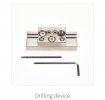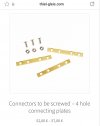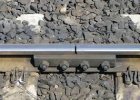You are using an out of date browser. It may not display this or other websites correctly.
You should upgrade or use an alternative browser.
You should upgrade or use an alternative browser.
Fish Plates
- Thread starter DafyddElvy
- Start date
Gavin Sowry
Garden Railroader and Raconteur
Huh, far from prototypical.
DafyddElvy
1:22.5 & 15mm Scale Trams, , NG Steam Railways
Other than machining them to match the rail profile I think these are pretty good representations, although a wee bitty pricey.Huh, far from prototypical.
Ralphmp
Registered
And they should also give pretty good connection for folks using live rails. Maybe a stupid question, but wouldn't bolting the rails together create problems when the rail expand/contract? I’ve deliberately avoided using clamps on every rail joint thinking that fishplates allow the rails to expand/contract without upsetting track geometry.
playmofire
Registered
A good point. I would have thought the holes should be slightly oval.And they should also give pretty good connection for folks using live rails. Maybe a stupid question, but wouldn't bolting the rails together create problems when the rail expand/contract? I’ve deliberately avoided using clamps on every rail joint thinking that fishplates allow the rails to expand/contract without upsetting track geometry.
DafyddElvy
1:22.5 & 15mm Scale Trams, , NG Steam Railways
Personally I will probably stick with traditional model railway fish plates, if I were to consider electric track power in the future, I have made provision for a feeder to be provided with a connection to each rail along the route.
If someone did use prototype fish plates I would suggest oversize or oval holes in the rail but keep the holes in the fish plates to a clearance fit.
If someone did use prototype fish plates I would suggest oversize or oval holes in the rail but keep the holes in the fish plates to a clearance fit.
Rhinochugger
Retired Oik
All of my rail joints are either clamped or connected using Aristo/Bachmann screwed rail joiners. I fix the track to whatever it's laid on at fairly infrequent intervals, every 6 feet or so, and I'm not aware of any expansion / contraction issues.but wouldn't bolting the rails together create problems when the rail expand/contract? I’ve deliberately avoided using clamps on every rail joint thinking that fishplates allow the rails to expand/contract without upsetting track geometry.
The electrical continuity offered by both these types of rail joiner far outweighs the issues of potential thermal movement. Sliding fishplates are not a good solution for outdoor track power
JimmyB
Now retired - trains and fishing
Even though I am "dead track" I use clamps and screw fishplates, and secure down in a few places, I have seem track float apart under use with ordinary fishplates.All of my rail joints are either clamped or connected using Aristo/Bachmann screwed rail joiners. I fix the track to whatever it's laid on at fairly infrequent intervals, every 6 feet or so, and I'm not aware of any expansion / contraction issues.
The electrical continuity offered by both these types of rail joiner far outweighs the issues of potential thermal movement. Sliding fishplates are not a good solution for outdoor track power
Rhinochugger
Retired Oik
I think LG do some sort of clip to keep the track sections together, but it's one of the areas where I've always been critical of LGB, where they just 'bigged up' practices from the smaller scales.Even though I am "dead track" I use clamps and screw fishplates, and secure down in a few places, I have seem track float apart under use with ordinary fishplates.
To a certain extent you can understand it as, when LGB was first introduced, it was advertised generally as an indoor train set (for people with big houses and big pockets) but there are some areas that they have failed to re-engineer even when there were known shortcomings, and the sliding fish plates is one example.
Greg Elmassian
Guest
Gavin Sowry
Garden Railroader and Raconteur
View attachment 304179
Well, pretty prototypical except for the heads of the bolts and perhaps the nuts could be smaller.
My point exactly, and also the fact that they do not actually fish (which means the plates are angled to the same as that of the underneath of the rail head, and the angle of the foot).
DafyddElvy
1:22.5 & 15mm Scale Trams, , NG Steam Railways
I can't find any M1.4 (scale size) with a hex head but I can find a dome head bolt which is prototypical for the earlier years, I did find an M1.5 bolt with a hex head so it is possible to get the bolts.My point exactly, and also the fact that they do not actually fish (which means the plates are angled to the same as that of the underneath of the rail head, and the angle of the foot).
Personally I think I'll still stick to old fashion conventional rail fish plates, I haven't decided how I'll be fixing the track in place yet, as my line will be a tramway I may use a cement infill in places, but that's a whole separate topic.
Rhinochugger
Retired Oik
In some ways, i can understand why someone might want to depict a more realistic type of rail joint .................... but then we'd be into a discussion about what a prototypical length of rail should be and how frequently they should be spaced 




... And whether you should 'stick' dummy fishplates on, and notch the railhead, for that authentic 'clickety-clack'?In some ways, i can understand why someone might want to depict a more realistic type of rail joint .................... but then we'd be into a discussion about what a prototypical length of rail should be and how frequently they should be spaced
Rhinochugger
Retired Oik
... And whether you should 'stick' dummy fishplates on, and notch the railhead, for that authentic 'clickety-clack'?




